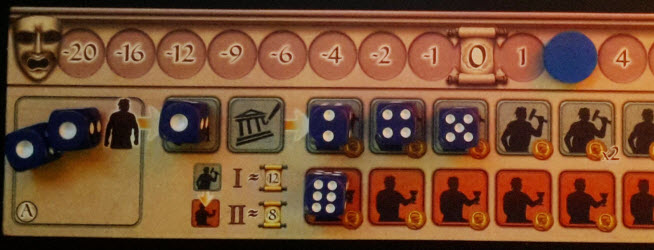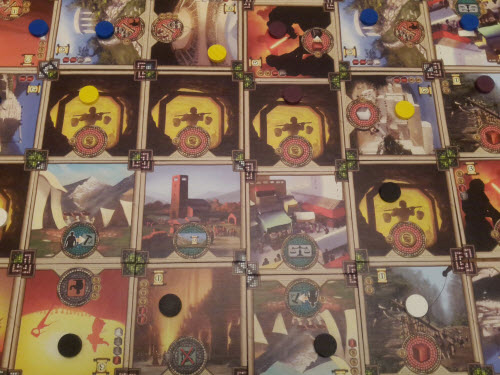Hail citizen, and welcome to Segedunum. As you surely saw upon entering camp, the fort’s palisades have gone up in record time, and we have been most diligent on the western patrols. The Caledonians have been quiet of late, yet we stand vigilant.
We are most gracious that you and your skills have come to us now. We may stand on the edge of civilization, but the glory of Rome shall be displayed prominently anywhere within its borders. That is where you come in.
We have many new followers in camp, and a thriving village has sprung up in less than a few seasons, for which we were not fully prepared. We could most benefit from your wise direction. Please let us know what your orders are. I have instructed our Praefectus castorum, Gaius Faustus, to provide anything you require.
-Titus Marcellinus, Legio secunda Augusta
The Premise
Emperor Hadrian has decreed that there be the creation of a vast territorial wall in northern Britain. The person who makes the biggest administrative impact will rule the region in his name as Praetor. Players take on the mantle of Roman engineers who have arrived to build up one of these settlements, both for personal ambition and for the eternal glory of Rome.
The Rules
Praetor is a tile-based dice-allocating Worker Placement game and requires a fair amount of space. The game comes with two principal tile types, Wall and City, and the City tiles used varies on the number of players. Praetor starts a number of purchasable tiles revealed, along with a core setup of three central City tiles and one gold mine per player.
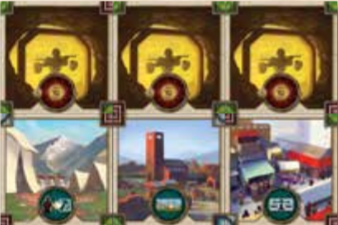
A normal 3-player base camp.
To begin, each player receives Worker dice, ownership markers, a handful of resources, and a double-sided player board. Player boards track a variety of information, including the player’s Morale (adding VP at the end of the game), market rates, and the state of their workers. Workers in Praetor exist as either Potential workers, Active workers, or Retired workers, and the number on each die reflects that worker’s experience level. Every player starts with three Active workers.
Praetor is played out over a series of rounds. For the first round, the player who has been to Rome most recently starts with the most Favor (VP) but goes last. In each subsequent round, turn order is based on VP totals, with the players having the least Favor going first.
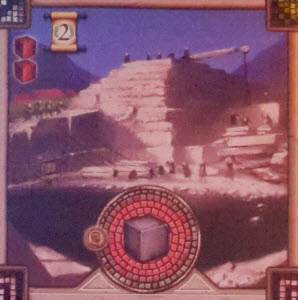
Activate for Stone!
On a player’s turn, they may either Build a City Tile or Activate a City Tile. To Build, the player selects an available tile and adds it to the camp. They must pay the tile’s costs (a combination of Gold, Wood, Marble, Stone, or Weapons) and must put both an Active dice worker and an ownership marker on that tile. In return, they score the tile’s VP amount as well as bonus points for each matching mosaic tile corner.
The other option is to Activate a City Tile. Each activation has a cost that must be paid to the tile’s owner, and they come in three kinds: Green, Red, and Grey. For a Green or Red activation, the player places an Active Worker and takes the action. Tiles generate resources, Favor, or Morale, recruit new workers, and construct pieces of Hadrian’s Wall. Tiles that generate basic resources provide amounts equal to that Worker’s experience level. By contrast, Grey activations don’t require a worker and can be used by multiple people but are still limited to once per player per round.
When a player runs out of usable workers, they pass. When all players pass, the round ends. Players then perform a series of upkeep steps. First, they retrieve all Active and new Workers. Each Worker who Built or used a Red activation has their experience rise by one. Any Worker who reaches 6 experience retires. Retired Workers score points but are normally no longer usable. Next, players must pay for each Active and Retired worker they have or risk losing Morale.
Finally, Wall and City tiles are replenished and turn order is recalculated. Then, a new round begins.

Go on…start walking
Rounds continue until either the City or Wall tile stack is depleted. At the end of the final round, players tally up their Favor. The player with the most Favor has displayed themselves to be the most worthy of Caesar Hadrian’s attention, and they are rewarded the province’s fancy new Praetorship.
Everyone else can either grab a shovel or sit and ruminate about what an abject failure of a Roman Patrician they are on the long ride home.
A Mosaic of Mosaics
Everyone plays games for different reasons. The appeal of worker placement games, by and large, is about deciphering a puzzle. These games give players a lot of choices, though there are only so many optimal moves you can make any given time. Worker placement games usually offer a multitude of strategies to navigate their systems, but ultimately it’s up to the players to figure out what they should do by studying the board and planning ahead.
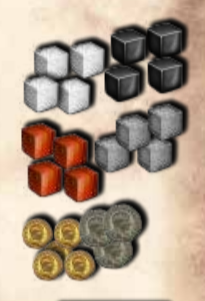
“Ok, it’s platinum…
but orange wood?”
Praetor takes a different approach by having a different sequence of tiles every game. Some games spit out a lot of resource-generating tiles early on, while others are more restrictive. All of the tiles eventually become available, but there is little guarantee of the precise order.
That said, it gives Praetor a fun city-building vibe, which ties nicely into its theme. Focusing on building City tiles is even a viable strategy.
As the city grows, the tiles also blend together to form a vibrant and visually pleasing landscape of colors across your table. Architects generally favor worker placement games to begin with, but this added facet will easily have them on board.
What’s less clear is whether there will be enough to entice your resident Immersionists. Indeed, while flavorful for a worker placement game, there isn’t a lot of depth to its setting beyond the deftly-drawn artwork and an expanding cityscape. Plus, they’re going to wonder why gold is worth less than silver.
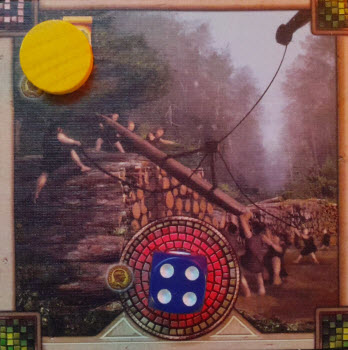
See how clean it looks?
The visuals can also be overshadowed by how “busy” the board gets. Although the tiles are well-sized, not everything is highly organized. The tile’s mosaic corners are a nice way to get extra points, but they could have benefited from being slightly larger on the tile.
Similarly, there is no dedicated spot on a tile for the ownership markers to be placed, and so they’re added haphazardly. This clutters up the layout, making Praetor seem more confusing than it is and forces the artwork into the background. To offset this, we recommend specifying one corner and stating that’s where the markers should be placed. It helps.
Adjusting To Your Environment
While the rules to Praetor are impressively easy to learn, it has a learning curve a Roman mile wide. Between having 21 different City tiles and the unpredictability of when they’ll show up, early playthroughs can be difficult to find your footing because of the constant needs to adjust throughout the game. Praetor provides a fantastic player guide for the tile explanations, but even with them it takes a couple sessions to become comfortable. It’s one among many, but this factor alone is enough to have Socializers skipping the race for praetorship.
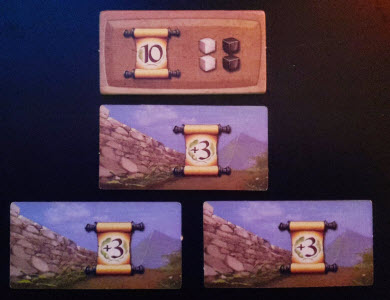
Focusing on the wall can create quite a lot of points over time.
On the other hand, once you get over the initial hurdle, the game is remarkably fluid with its strategy. If Wood is scarce, the Market becomes a viable option. If everyone is clamoring build the Wall, you pivot to using temples.
What makes Praetor stand out is that it gives you the option to adjust each round and still letting you plan ahead. Even for a tile game, Praetor has plenty of room for forethought, which Tacticians love.
However, although it has an admirable amount of flexibility for a worker placement game…it’s still a worker placement game. Sorry Daredevils, but this Roman town favors organization over hedonism.
Turn order also plays a big role in Praetor. Going first ensures that you have the first chance to build a new City tile, take an action key to your plans, or beat a competing player to the same contested location. It’s not uncommon to have players jockeying for turn position, even actively trying to earn slightly fewer points in a given round. It certainly can be advantageous – so long as you don’t fall too far behind other players.
The result is that, most of the time, Praetor is a remarkably tight game that keeps people engaged. Even with a full compliment of players, you can have several people with very close final scores. It also often has players regularly jostling with each other over key locations to give themselves the upper hand – or to block an opponent. Although Praetor is not a highly aggressive game, it does have its share of close competition, and Strikers should actually find this worker placement game appealing to their inner legionnaire.

Labor Troubles
There is, however, one tile that can unravel the whole game cohesion – the Labor Camp. More specifically, the Labor Camp with a three gold activation. With a table full of inexperienced players, the Labor Camp can be so problematic that simply owning it wins games.
The Labor Camp allows each player to pay its owner to use a Retired worker. In theory this is fine: one player gets a few coin and the other gets to put to task a 6-experience worker.
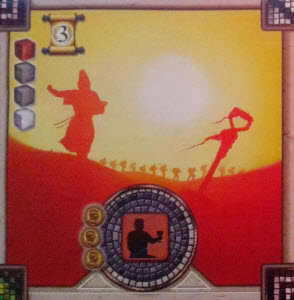
What a troublemaker…
The problem is that it generates a huge tempo swing if players routinely activate it. And they will. During your first few playthroughs of Praetor, it’s easy to have a worker retire too early, and the allure of paying a few gold to use it again is almost impossible to resist.
A table of four or five people utilizing the Labor Camp ensures that its owner won’t have to spend a worker to get money, instead freeing them up to use it elsewhere. Having multiple people feeding the Labor Camp every round generates such a distinct advantage that it will put the owner is in a good position to win. And if one player buys up both Labor Camps, it’s almost a guarantee.
While it’s certainly powerful in its own right, this usually happens because players have a worker or two retire too early and don’t feel they have a choice if they want to remain competitive. Aside from having to resort to house rules, though, there actually are two ways to diminish the impact of the Labor Camp on the game:
- Use the B-Sides of the player boards: Unlike the A-Sides of the boards which are all identical, the B-Sides are unique. One B-side may encourage you to focus on gaining morale, while another makes it cheaper to have Active Workers. Not only do the B-Sided boards add extra replayability for Praetor, it forces you to differentiate your strategies from one another. They do add extra complexity to the game – which is why they aren’t suggested for new players – but different strategic focuses put much less emphasis on the Labor Camp’s necessity.
- Don’t activate it: Really. Accept that the owner gets its free use and try another tactic. For instance, if you focus on keeping your workers Active as long as possible, you minimize the reliance on needing to use Retired workers. Then it becomes more of a luxury. Without that foreknowledge, though, it can be hard to avoid.
The Takeaway
Praetor embodies part of the experience of Hadrian’s Wall without having to travel to the English countryside. It has everyone taking on the role of Roman engineers, and in many ways it’s fitting. Players make impactful strategic decisions for the camp, and the variable tile layout and player boards ensure that the game is repeatable without being repetitive. It’s impressive how close final scores can be, even if during the course of the game it may not seem that way. However, just like real engineering, at least some experience is necessary; it will take a playthrough or two to fully unlock its potential. The board can feel busy at times and players must be acutely aware of the power of labor, although both can be mitigated. Still, Praetor is a capable and competitive worker placement game with an enjoyable theme, and although there may be a few cracks in the mortar here and there, it still proves to be a worthwhile piece of construction.
Praetor is a product of NSKN Games.
Cardboard Republic Snapshot Scoring (Based on scale of 5):
Artwork: 3.5
Rules Clarity: 4.5
Replay Value: 4
Physical Quality: 4
Overall Score: 4
Photo Credits: Hadrian’s Wall by Wikipedia.

